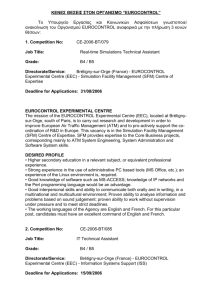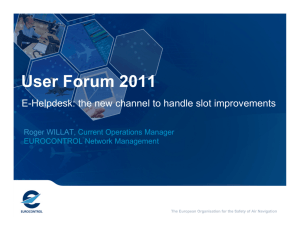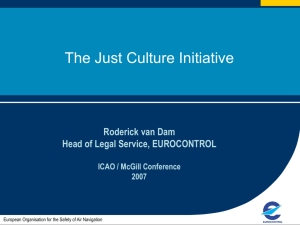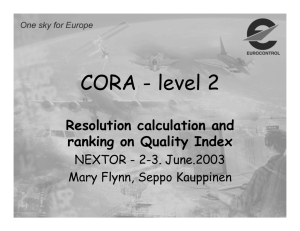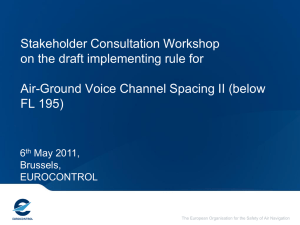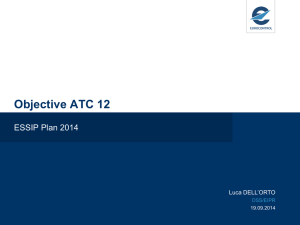European Medium-Term Conflict Detection Field Trials FAA/NEXTOR
advertisement
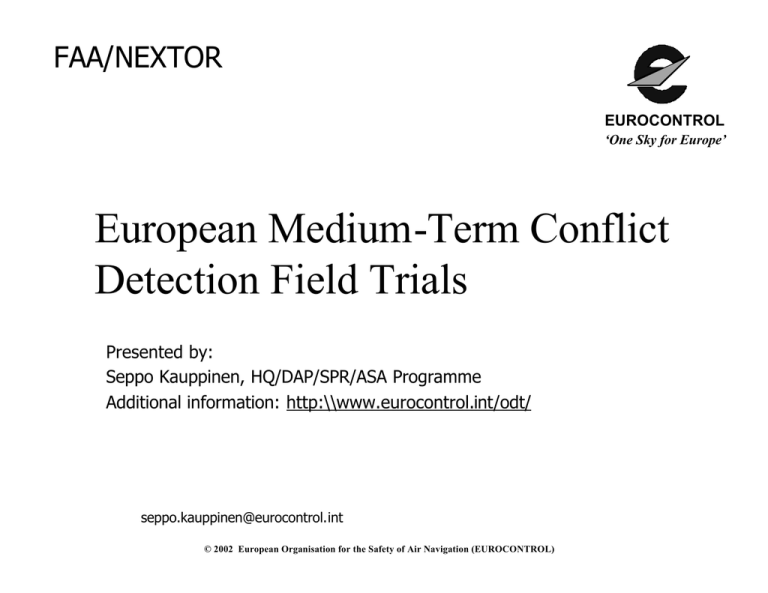
FAA/NEXTOR EUROCONTROL ‘One Sky for Europe’ European Medium-Term Conflict Detection Field Trials Presented by: Seppo Kauppinen, HQ/DAP/SPR/ASA Programme Additional information: http:\\www.eurocontrol.int/odt/ seppo.kauppinen@eurocontrol.int © 2002 European Organisation for the Safety of Air Navigation (EUROCONTROL) FAA/NEXTOR Presentation • • • • EUROCONTROL ‘One Sky for Europe’ ASA; Medium-Term Conflict Detection Field Trials Results from Rome Conclusions •2 © 2002 European Organisation for the Safety of Air Navigation (EUROCONTROL) FAA/NEXTOR EUROCONTROL ‘One Sky for Europe’ •3 © 2002 European Organisation for the Safety of Air Navigation (EUROCONTROL) FAA/NEXTOR EUROCONTROL ‘One Sky for Europe’ MTCD is a planning tool •4 © 2002 European Organisation for the Safety of Air Navigation (EUROCONTROL) FAA/NEXTOR WHY MTCD ? EUROCONTROL Safet y-a ‘One Sky for Europe’ t f a i n plann ds th rs e s e u ing le c o t o t h n e a vel flict c i t s v m r e t e i u g ht be rs ro e t e t y e e r s f . misse bu eb … d n i e v … h o d w es Pr t n u e o r v e ct s e r e i l i d f pro m u optim Early conflict detection with less uncertainty leading to optimum resolution m a e t r o ct cy e n s e i e c i c f ef lan a e v b o e r p R m i d a worklo r team to in sec Improves tr affic awaren ess Provides future workload indication © 2002 European Organisation for the Safety of Air Navigation (EUROCONTROL) •5 FAA/NEXTOR WHY MTCD ? EUROCONTROL ‘One Sky for Europe’ Have we missed a conflict ? Are there any conflicts coming ? How far apart will these two be ? •6 © 2002 European Organisation for the Safety of Air Navigation (EUROCONTROL) FAA/NEXTOR Acronyms Programmes/sub-programmes: • EATMP = European Air Traffic Management Programme • ASA = Automated Support to Air Traffic Services (Programme) Functions/tools: • AMAN = Arrival Management • APW = Area Proximity Warning • CORA = Conflict Resolution Assistant • DMAN = Departure Management • EMAN = Enroute Management • MSAW = Minimum Safe Altitude Warning • MTCD = Medium- Term Conflict Detection • STCA = Short- Term Conflict Alert ATS Units: • ACC = Area Control Centre • UAC = Upper Area Control Centre EUROCONTROL ‘One Sky for Europe’ EUROCONTROL validation platforms: • ESCAPE = Eurocontrol Simulation Capability & Platform Experimentation • PROVE = Pr Pre-O Operational Validation & Experimental Trials Platform FAA: • URET = User Request Evaluation Tool •7 © 2002 European Organisation for the Safety of Air Navigation (EUROCONTROL) FAA/NEXTOR Field Trials in EATMP Lifecycle EUROCONTROL ‘One Sky for Europe’ Analytic modeling Fast-time simulation Field test Small-scale real-time simulation Shadow-mode trial Operational trial Operations Large-scale real-time simulation Back © 2002 European Organisation for the Safety of Air Navigation (EUROCONTROL) •8 FAA/NEXTOR Human-in-the Loop Planning Controller Monitor Operational Data Issue Clearances Adapt Flight Plans Observe conflict display Transfer conflict to TC ‘One Sky for Europe’ MTCD Inspect predicted trajectories for conflict situations Inform controller about conflict Estimate gravity of conflict Acknowledge conflict EUROCONTROL Store necessary conflict data Create conflict resolution Delete conflict data Resolve the conflict © 2002 European Organisation for the Safety of Air Navigation (EUROCONTROL) •9 FAA/NEXTOR MTCD Architecture EUROCONTROL ‘One Sky for Europe’ • Platform uses a client/server architecture with a CORBA-based middleware. • MTCD is a server with HMI as a client • MTCD uses information provided by Trajectory Prediction service • Stimulated by a “tick” service (every 5-sec). • MTCD provides conflict to HMI (createupdate-delete) © 2002 European Organisation for the Safety of Air Navigation (EUROCONTROL) •10 FAA/NEXTOR Conflict Detection (Diagram of components and their relationships) EUROCONTROL Concept of Use ‘One Sky for Europe’ Wa rn rem ings Re inder and req minde s ues r ts Conflict data ce ran lea w c data d Ne te dic ry Pre jecto tra Controller CWP HMI MTCD New trajectory data Monitoring Aids New trajectory data Trajectory prediction Recalculation triggers •11 © 2002 European Organisation for the Safety of Air Navigation (EUROCONTROL) FAA/NEXTOR MTCD Overview EUROCONTROL ‘One Sky for Europe’ • Traffic evolution is specified by a set of trajectories. • Trajectories examined in pairs and reported, if trajectories come too close •12 © 2002 European Organisation for the Safety of Air Navigation (EUROCONTROL) FAA/NEXTOR Trajectory Prediction; Initial EUROCONTROL ‘One Sky for Europe’ Planned Trajectory calculated initially according to flight plan, aircraft performance (BADA) and ATC constraints ALM Sector 1 Sector 2 Sector 3 RFL330 LOA-XFL290 LOA-XFL270 X ALM FL90 or Climb as early as possible Descend as late as possible •13 © 2002 European Organisation for the Safety of Air Navigation (EUROCONTROL) FAA/NEXTOR MTCD Calculations EUROCONTROL ‘One Sky for Europe’ • Projection system used, WGS-84 • MTCD transfers lat/long to projection plane • We calculate in flat projection having ensured that errors were insignificant – worst case for relative distance of 5NM is 0.05NM with maximum segments of 50NM • Aircraft are assumed to fly along a straight line, in reality along a great circle •14 © 2002 European Organisation for the Safety of Air Navigation (EUROCONTROL) FAA/NEXTOR Timeslice Filtering Conflict possible in 2nd Timeslice EUROCONTROL ‘One Sky for Europe’ Timeslice Areas 1st 2nd 3rd •15 © 2002 European Organisation for the Safety of Air Navigation (EUROCONTROL) FAA/NEXTOR Uncertainty Modelling with buffer zone now +10 mins EUROCONTROL ‘One Sky for Europe’ +20 mins Perfect Prediction Reality Uncertain Model with Buffer © 2002 European Organisation for the Safety of Air Navigation (EUROCONTROL) •16 FAA/NEXTOR Vertical Uncertainties EUROCONTROL ‘One Sky for Europe’ Fast Climb Slow Climb Early Climb Late Climb •17 © 2002 European Organisation for the Safety of Air Navigation (EUROCONTROL) FAA/NEXTOR MTCD Checks for horizontal separation loss between buffers EUROCONTROL ‘One Sky for Europe’ •18 © 2002 European Organisation for the Safety of Air Navigation (EUROCONTROL) FAA/NEXTOR Field Trials EUROCONTROL ‘One Sky for Europe’ •19 © 2002 European Organisation for the Safety of Air Navigation (EUROCONTROL) FAA/NEXTOR Trials Objectives (2) EUROCONTROL ‘One Sky for Europe’ • Evaluate Controller roles, tasks and working methods when using MTCD tools – to identify, analyse, monitor and resolve problems in a stripless environment • Identify tasks where use of MTCD leads to time saving for the Controller in order to estimate the potential impact on controller workload • Permit ATS providers to conduct an analysis of MTCD in their own system to identify and quantify future implementation risks, constraints and challenges •20 © 2002 European Organisation for the Safety of Air Navigation (EUROCONTROL) FAA/NEXTOR Trials Partners Malmo ACC EUROCONTROL ‘One Sky for Europe’ Rome ACC •Generic validation plan produced by UK NATS •Analysis done by Dutch National Airspace Laboratory •Safety analysis by SOFREAVIA EUROCONTROL Maastricht UAC © 2002 European Organisation for the Safety of Air Navigation (EUROCONTROL) •21 FAA/NEXTOR We use PROVE? EUROCONTROL ‘One Sky for Europe’ • A live field trials infra-structure deployed in many ACCs around Europe “LIVE” • AFTN (FPLs) • Radar Tracks • R/T Copenhagen Data (OLDI) / Voice (Audiolan) Malmö •22 © 2002 European Organisation for the Safety of Air Navigation (EUROCONTROL) FAA/NEXTOR PROVE Platform TIS-B ADS-B Asterix Cat 62 Asterix Cat 21 Asterix Cat 1&2 Radars EUROCONTROL ‘One Sky for Europe’ PROVE ARTAS Asterix Cat 32 Asterix Cat 62 Track Gateway Operational System Correlation FPL Gateway AFTN ICAO Telecoms © 2002 European Organisation for the Safety of Air Navigation (EUROCONTROL) •23 FAA/NEXTOR Technical System EUROCONTROL ‘One Sky for Europe’ Host ACC System System flight plans radar data ALENIA Interface Component PROVE FDP TP MONA MTCD HMI © 2002 European Organisation for the Safety of Air Navigation (EUROCONTROL) •24 FAA/NEXTOR MTCD CWP EUROCONTROL ‘One Sky for Europe’ •25 © 2002 European Organisation for the Safety of Air Navigation (EUROCONTROL) FAA/NEXTOR EUROCONTROL ‘One Sky for Europe’ •26 © 2002 European Organisation for the Safety of Air Navigation (EUROCONTROL) FAA/NEXTOR MTCD Problem Display EUROCONTROL ‘One Sky for Europe’ •27 © 2002 European Organisation for the Safety of Air Navigation (EUROCONTROL) FAA/NEXTOR Results EUROCONTROL ‘One Sky for Europe’ Results are available through the EUROCONTROL Experimental Centre WEB: www.eurocontrol.fr •28 © 2002 European Organisation for the Safety of Air Navigation (EUROCONTROL) FAA/NEXTOR PC Decision Process no Detection of problems in the PPD Get problem oriented flight leg ‘One Sky for Europe’ Lowlight Decide: problem? no yes EUROCONTROL Resolve by co-ordinating PEL/XFL Decide: TC problem? yes Highlight or transfer early or put on warning •Cognitive process/state •Actions in the EATMP system •29 © 2002 European Organisation for the Safety of Air Navigation (EUROCONTROL) FAA/NEXTOR Workload Assessment EUROCONTROL ‘One Sky for Europe’ • Main point of MTCD is a more equal distribution of workload within the sector. – PC to take over some of TC’s workload • Methods: • NASA Task Load Index (to assess the experienced level of workload), and • Interviews on the level of experienced workload as well as on anticipated workload changes. •30 © 2002 European Organisation for the Safety of Air Navigation (EUROCONTROL) FAA/NEXTOR Usability Assessment • • • • EUROCONTROL ‘One Sky for Europe’ Goals of use achieved (Effectiveness) Resources to achieve goals (Efficiency), Use is acceptable (Satisfaction). Methods: • System Usability Scale (Brooke, 1998), • Interviews on the usability of different system components, and • Observation of system interaction. •31 © 2002 European Organisation for the Safety of Air Navigation (EUROCONTROL) FAA/NEXTOR Human Computer Trust Rating Scale EUROCONTROL ‘One Sky for Europe’ • Measures (scale 0-20) • Understandability, Technical Competence, Perceived Reliability, Faith, Personal Attachment • Trust ratings were generally higher on Day 5 than on Day 1 of the validation • Mean score (10) is middle of the scale • Statistically significant increase was observed only for understandability •32 © 2002 European Organisation for the Safety of Air Navigation (EUROCONTROL) FAA/NEXTOR Situation Awareness EUROCONTROL ‘One Sky for Europe’ • Built on aircraft-oriented flight leg and Extended Label Window • sort of an electronic strip presentation • PPD used for conflicts and risks. • PPD was second step after an understanding of traffic situation built by radar. • PPD data used with own understanding of traffic situation. •33 © 2002 European Organisation for the Safety of Air Navigation (EUROCONTROL) FAA/NEXTOR Expected Changes In Controller Task EUROCONTROL ‘One Sky for Europe’ • PC/TC thought operational system like tried would considerably change their task. • MTCD is expected to change when and by whom conflicts are solved: • conflicts solved earlier, and often by PC • Controllers expect problems (e.g. de-skill, over-trust), if future controllers would stop monitoring the traffic situation •34 © 2002 European Organisation for the Safety of Air Navigation (EUROCONTROL) FAA/NEXTOR Rome trial statistics EUROCONTROL ‘One Sky for Europe’ • 24:30 hours of shadow mode trials – 10 active sessions – 14 advanced sessions 11hrs25 13hrs05 Active Advanced •35 © 2002 European Organisation for the Safety of Air Navigation (EUROCONTROL) FAA/NEXTOR Rome trial statistics EUROCONTROL ‘One Sky for Europe’ • Conflicts and risks detected by MTCD 99 Conflicts Risks 257 – 54 conflicts disappeared within 10 seconds. – 95 conflicts were lowlighted. •36 © 2002 European Organisation for the Safety of Air Navigation (EUROCONTROL) FAA/NEXTOR Situation Awareness EUROCONTROL ‘One Sky for Europe’ • Earlier conflict identification due to: – MTCD information in PPD and flight leg, – early correlation of traffic at PROVE platform. • Better insight into problem geometry due to: – display of minimum distance, – information on aircraft position. • Benefits sometimes limited by: – nuisance alerts, – large changes in predicted minimum distance over time. •37 © 2002 European Organisation for the Safety of Air Navigation (EUROCONTROL) FAA/NEXTOR Workload EUROCONTROL ‘One Sky for Europe’ • Experienced level of workload higher for Trial team than for OPS team (TLX), but – large training difference between current system and EATMP system, – EATMP system is an experimental system, – controllers combine conventional working methods with analysis of MTCD information. • With more training and an approved operational system, decreases in workload are expected. •38 © 2002 European Organisation for the Safety of Air Navigation (EUROCONTROL) FAA/NEXTOR Safety EUROCONTROL ‘One Sky for Europe’ • MTCD and MONA are expected to increase safety, because of: – Early conflict detection, – Monitoring of track deviations, – Transfer reminders. • No new safety risks associated with MTCD were identified. •39 © 2002 European Organisation for the Safety of Air Navigation (EUROCONTROL) FAA/NEXTOR Shadow mode trials EUROCONTROL ‘One Sky for Europe’ • (Advanced) shadow mode is a suitable way of testing a new system. • Controllers are less tolerant towards system problems and restrictions in advanced shadow mode. • System “limitations” mostly identified in advanced shadow mode – uncertainty in trajectory prediction, – trajectory re-calculation, – effect of wind. •40 © 2002 European Organisation for the Safety of Air Navigation (EUROCONTROL) FAA/NEXTOR Conclusions EUROCONTROL ‘One Sky for Europe’ • Controllers felt confident to progress to advanced shadow mode in high traffic load. • Concept of MTCD highly appreciated by controllers. • Crucial aspects in the introduction of MTCD: – Controller working methods, – Knowledge of system potential and limitations. •41 © 2002 European Organisation for the Safety of Air Navigation (EUROCONTROL) FAA/NEXTOR Workload EUROCONTROL ‘One Sky for Europe’ Mean NASA TLX ratings as a function of team and controller role 20 18 16 14 12 10 8 6 4 2 0 OPS team Planning Controller Tactical Controller Trial Team •42 © 2002 European Organisation for the Safety of Air Navigation (EUROCONTROL)
